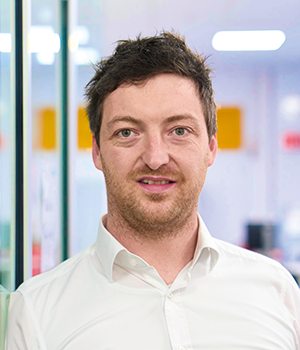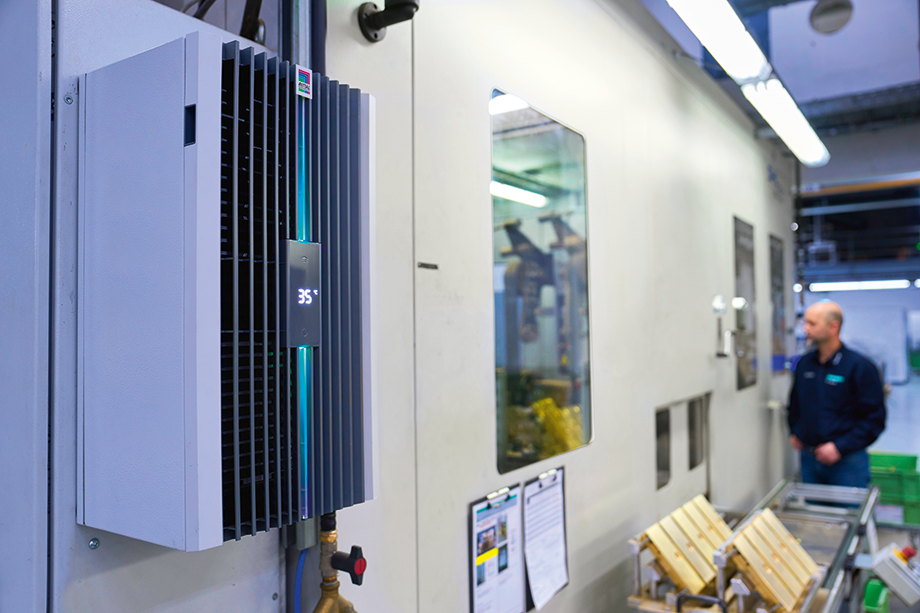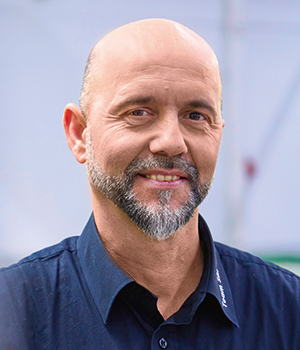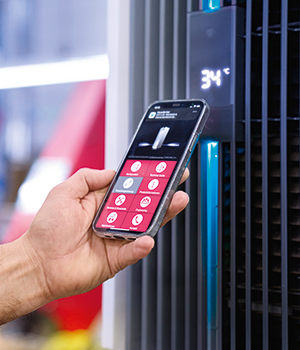Text Ralf Steck ––– Photography
Sustainability, environmental friendliness and energy efficiency have been key priorities at Hansgrohe SE for a great many years now. Back in 1992, when the company started operating its solar power plant on top of its new production facilities in Offenburg, this was, in fact, the biggest roof-mounted solar power plant in the world. Moreover, in 1995, Hansgrohe SE became the first industrial company to win the environmental prize awarded by the Baden-Württemberg Ministry of the Environment. All the company’s sites, both in Germany and worldwide, have been climate-neutral since 2021 and 2022 respectively.
It therefore came as no surprise that, when Rittal asked Hansgrohe whether it would like to try out one of the new enclosure cooling units in the Blue e+ S series, the company’s managers jumped at the chance. “This sort of thing is always of interest to us,” says Johannes Kopf, Investment Planning Project Manager at Hansgrohe. “Our vertical integration is very extensive, so we also have a large number of machines and enclosures. We therefore use a lot of climate control units, too. Although each individual climate control unit uses relatively little electricity compared to machines and robots, the sheer quantity of these units means that, when you add them all together, their total energy consumption is pretty significant.”
Stefan Eibach, Enclosure Climate Control Product Manager at Rittal, adds: “We already knew that Hansgrohe attaches a great deal of importance to energy efficiency. That’s why we put this company very high up on the list when we were choosing customers to try out our new, compact and energy-saving climate control units.”
THE PERFECT TEST ENVIRONMENT
The two companies opted to conduct the trial in the grinding and polishing facility, where robots in six production lines bring a high sheen to the cast and milled metal parts used in Hansgrohe products. Even though the dust produced by the grinding process is extracted, the air in the grinding facility still contains many particles that can pollute the cooling unit. What’s more, the machinery and grinding processes themselves generate heat – the air is hot and quickly becomes dusty, which makes this an ideal environment for putting a cooling unit through its paces.
CHECK LIST IN THE NAME OF EFFICIENCY
Before the first test unit was installed, Rittal conducted a service and efficiency check of the entire production facility in Schiltach. Rittal developed this standardised procedure as a means of providing its customers with reliable figures about potential savings in connection with enclosure cooling.
Judith Kötzsch, Vice President Business Development Service at Rittal, explains the process. “The first step in our efficiency check involves documenting the current state of affairs. We look at which machines are present, how old they are and what condition they are in. A dirty cooling unit that hasn’t had any maintenance work done on it for years uses more energy than a unit that is the same age but, most importantly, has had its heat exchanger and filters cleaned on a regular basis. We also ask about the regional electricity price and the working hours – in other words, the number of shifts during which the machines are operational.
This data is then used to perform an initial analysis to work out the current energy consumption and suitable countermeasures, ranging from carrying out maintenance to replacing certain units entirely. This means we can calculate potential energy savings, the associated amortisation period, cost savings over a number of years and the reduction in CO2 emissions, and then present these figures to the customer. The customer is therefore given a full list of measures, complete with the cost and financial benefit of each one.
750 W COOLING UNIT PUT TO THE TEST
As an option, a trial of a new unit can also be used to verify the cost benefits that have been calculated. If required, certified subsidy managers at Rittal can help the company concerned find appropriate energy-related funding schemes that will help the investment pay for itself even faster. Once the energy check has been completed, Rittal works with the customer to implement the list of measures. “Existing enclosure cooling units in Germany are ten years old on average. This means they are rapidly approaching the age when it’s well worth replacing them with a cooling unit in the very latest efficiency class,” adds Kötzsch.
A CONSTANT OVERVIEW OF EVERYTHING
At Hansgrohe, too, an efficiency and service check of this kind was the first item on the agenda. Once this had been completed, the SK 3361.100 cooling unit at one of the grinding centres was replaced with a unit from the latest-generation Blue e+ S range with a rated output of 750 Watts. “It all happened very quickly,” recalls Hakan Zahal, who operates the system. “In late October 2022, the Rittal service engineers replaced the cooling unit for one of the enclosures, and it took them less than two hours. It was all very straightforward, since the only thing that needed to be modified was the cutout in the enclosure door. The electrical connections all fitted, so it was simply a case of plugging things into different sockets, including the door-operated switch and the fault signal relay.
Zahal goes on to describe the company’s initial experience of the new unit. “It just works away in the background and actually saves us work, too. Our old cooling unit didn’t have integrated condensate
“You can use the Scan & Service app to check the cooling unit when you’re walking past it and then you know immediately that everything is OK,” says Zahal, referring to another significant benefit of the Blue e+ units. The new units send data to a smartphone or tablet by various means including NFC transmission. System messages, the unit’s current settings and other data are also all recorded and displayed. Kopf has been positively surprised by the energy savings that were forecast by Rittal and are now indeed being achieved in ongoing operations. “Everybody knows that you can achieve energy savings of 20 to 30 per cent with a new, energy-efficient unit. However, Rittal promised us some 60 per cent – and, sure enough, we’re currently achieving savings of 61 per cent in our actual operations.
To be honest, it really surprised us. What’s more, if we disregard the integrated condensate evaporation – in other words, if we carry out a like for like comparison with our old unit – this figure actually rises to 70 per cent.” Kopf then sums up the results of the trial to date. “So far, the trial has all taken place during the autumn and winter – and yet we’ve still recorded large percentage savings. Due to the integrated heat pipe, we’re likely to see even higher savings over the summer. In any event, the Blue e+ S has certainly exceeded our expectations. What’s more, Rittal has proved that the data that was calculated during the efficiency check can also be achieved in practice. We are definitely going to implement further recommendations from the efficiency check bit by bit, with a view to optimising energy consumption in our production plant.”




